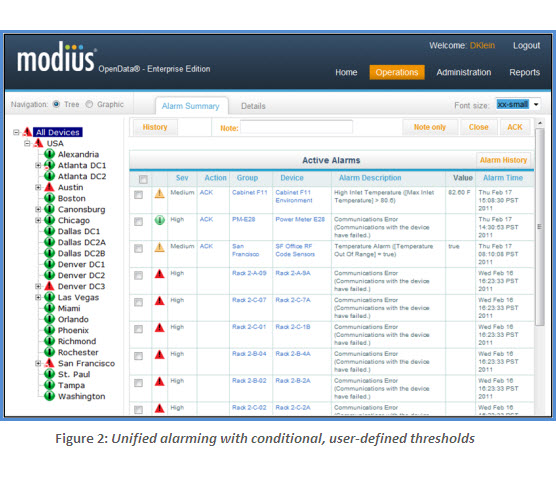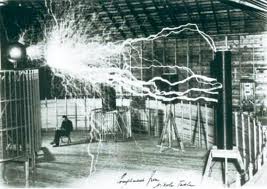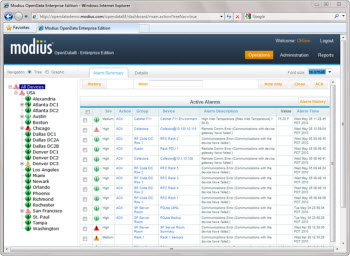We are sometimes asked how Modius OpenData is different than a BMS. “Why should I consider Modius OpenData when I already have a BMS?”
In short, the answer comes down to using the right tool for the job. A BMS is installed at a large building to monitor and control the environment within that building, for example: lighting, ventilation, and fire systems. It helps facility managers better manage the building’s physical space and environmental conditions, including safety compliance. As concerns about energy conservation have gained critical mass, feature enhancements to BMSs have evolved to become more attuned to energy efficiency and sustainability. However, this doesn’t make a BMS a good tool for data center optimization any more than a scissors can be substituted for a scalpel.
Unlike a BMS, OpenData software by Modius was designed to uncover the true state of the data center by continually measuring all data points from all equipment, and providing the incisive decision support required to continually optimize infrastructure performance. Both facility and IT managers use OpenData to gain visibility across their data center operations, to arrive at an energy consumption baseline, and then to continually optimize the critical infrastructure of the data center—from racks to CRACs. The effectiveness of the tool used for this purpose is determined by the:
- operational intelligence enabled by the reach and granularity of data capture, accuracy of the analytics, and the extensibility of the feature set to utilize the latest data center metrics
- unified alarm system to mitigate operational risk
- ease-of-use and flexibility of the tool to simplify the job
To illustrate, following are the top three differences between OpenData and a typical BMS that make OpenData the right tool to use for managing and optimizing data center performance.
- OpenData provides the operational intelligence, enabled by the reach and granularity of data capture, accuracy of the analytics, and the extensibility of the feature set, to utilize the latest data center metrics. Modius understands that data center managers don’t know what type of analysis they will need to solve a future problem. Thus, OpenData provides all data points from all devices, enabling data center managers to run any calculation and create new dashboards and reports whenever needed. This broad and granular data capture enables managers to confidently assess their XUE[1], available redundant capacity, and any other data center metric required for analysis. Moreover, because all of the data points provided can be computed at will, the latest data center metrics can be implemented at any time. In contrast, a BMS requires identifying a set of data points upon its installation. Subsequent changes to that data set require a service request (and service fee), which means that even if the data is collected in real-time, it may not be available to you when needed. Thus, the difficulty and expense of enabling the networked communications and reporting for real-time optimization from a BMS is far beyond what most would consider a “reasonable effort” to achieve.
- OpenData provides a unified alarm system to mitigate operational risk. With OpenData, end-users can easily set thresholds on any data point, on any device, and edit thresholds at any time. Alarms can be configured with multiple levels of escalation, each with a unique action. Alarms can be managed independently or in bulk, and the user interface displays different alarm states at a glance. In contrast, with a typical BMS integration the system only reports alarms native to the device—i.e., it doesn’t have access to alarms other than its own mechanical equipment. When data center managers take the extra steps to implement unified alarming (e.g., by feeding into the BMS the relay outputs or OPC server-to-server connections from the various subcomponents), they will often only get the summary alarms as a consequence of the cost charged per point and/or the expense of additional hardware modules and programming services to perform the communication integration with third-party equipment. Thus, when personnel receive an alarm, they have to turn to the console of the monitoring system that “owns” the alarming device to understand what is happening.

- Ease of use and flexibility to simplify the job. OpenData is designed to be user-driven: it is completely configurable by the end-user and no coding is required, period. Learning how to use OpenData takes approximately a day. For example, OpenData enables users to add new calculations, adjust thresholds, add and remove equipment, and even add new sites. In contrast, using a BMS to pro-actively make changes is virtually impossible to administer independently. Because the BMS is typically one component of a vendor’s total environmental control solution, the notion of “flexibility” is constrained to what is compatible with the rest of their solution offerings. Consequently, a BMS adheres to rigid programming and calculations that frequently require a specialist to implement changes to the configuration, data sets, and thresholds.
In summary, the only thing constant in data centers is flux. Getting the right information you need—when you need it—is crucial for data center up-time and optimization. For the purpose of performance monitoring and optimization, using a BMS is more problematic and ultimately more expensive because it is not designed for broad and granular data capture, analysis and user configuration. Ask yourself: What would it take to generate an accurate PUE report solely using a BMS?
The following table summarizes key differences between OpenData and a BMS, including the impact to data center managers.

[1] The “X” refers to the usage effectiveness metric de jour, whether it is PUE, pPUE, CUE, WUE, or something new.

 On top of that, making sense of the various alarm schemas—which are so vital to maintaining control of data center performance and achieving a higher level of efficiency—can be more of a headache than the alarm system is worth. They typically don’t factor input from the full gamut of facility and IT equipment into their respective alarm thresholds. Consequently, spurious alerts from the disparate alarm systems trip over themselves and conceal the true state of the data center.
On top of that, making sense of the various alarm schemas—which are so vital to maintaining control of data center performance and achieving a higher level of efficiency—can be more of a headache than the alarm system is worth. They typically don’t factor input from the full gamut of facility and IT equipment into their respective alarm thresholds. Consequently, spurious alerts from the disparate alarm systems trip over themselves and conceal the true state of the data center. Modius offers OpenData Standard Edition, a low-cost unified alarm management and notification solution for monitoring all power and cooling equipment, including IT racks. At only $1,995 per user per year, it is the only solution in the industry offered at a very low cost and distributed as a downloadable, easy-to-install software package. This low-cost offering reduces the risk of “locking in” to a solution without having it thoroughly tested in your environment, on your own terms.
Modius offers OpenData Standard Edition, a low-cost unified alarm management and notification solution for monitoring all power and cooling equipment, including IT racks. At only $1,995 per user per year, it is the only solution in the industry offered at a very low cost and distributed as a downloadable, easy-to-install software package. This low-cost offering reduces the risk of “locking in” to a solution without having it thoroughly tested in your environment, on your own terms. Computational Fluid Dynamic (CFD) software provides modeling of data center airflow and quick identification of hot spots. A CFD system’s three-dimensional, multi-colored thermal maps are downright sexy, and, if you’ll pardon the pun, extremely cool. When changes are made to the data center intentionally, CFD analysis can be repeated to detect the introduction of new thermal problems. So far, so good.
Computational Fluid Dynamic (CFD) software provides modeling of data center airflow and quick identification of hot spots. A CFD system’s three-dimensional, multi-colored thermal maps are downright sexy, and, if you’ll pardon the pun, extremely cool. When changes are made to the data center intentionally, CFD analysis can be repeated to detect the introduction of new thermal problems. So far, so good. But what happens when the data center changes unintentionally? Today, CFD users require real-time thermal imaging of hot spots that could result from contingencies like equipment failure, blockage or cabinet overloading. Furthermore, users want more than just problem visualization – they want recommendations for problem mitigation. They want a CFD model with some muscle – in effect, a CFD on steroids.
But what happens when the data center changes unintentionally? Today, CFD users require real-time thermal imaging of hot spots that could result from contingencies like equipment failure, blockage or cabinet overloading. Furthermore, users want more than just problem visualization – they want recommendations for problem mitigation. They want a CFD model with some muscle – in effect, a CFD on steroids. The next level of growth in temperature control is temperature-based reaction. Data Center operators are now looking not only at identification but also action automation through demand-driven cooling directly to the cabinet. By leveraging Variable Frequency Drives (VFD) in cooling units, remote commands can adjust cooling at the point of demand. This can reduce power costs substantially and can prevent a cabinet meltdown. Automated actions can be taken with the existing Building Management System (BMS) without having to rip out and replace the entire system. Integration of CFD can make the BMS smarter - processing and synthesizing a vast array of data, encoding commands in building-management language, and passing reliable information to the appropriate destination so that the secure communication infrastructure can be fully maintained. Modius OpenData is currently being leveraged by customers to pump up their BMS, leverage the current infrastructure, prevent cooling related outages, and save money in power-related cooling.
The next level of growth in temperature control is temperature-based reaction. Data Center operators are now looking not only at identification but also action automation through demand-driven cooling directly to the cabinet. By leveraging Variable Frequency Drives (VFD) in cooling units, remote commands can adjust cooling at the point of demand. This can reduce power costs substantially and can prevent a cabinet meltdown. Automated actions can be taken with the existing Building Management System (BMS) without having to rip out and replace the entire system. Integration of CFD can make the BMS smarter - processing and synthesizing a vast array of data, encoding commands in building-management language, and passing reliable information to the appropriate destination so that the secure communication infrastructure can be fully maintained. Modius OpenData is currently being leveraged by customers to pump up their BMS, leverage the current infrastructure, prevent cooling related outages, and save money in power-related cooling.